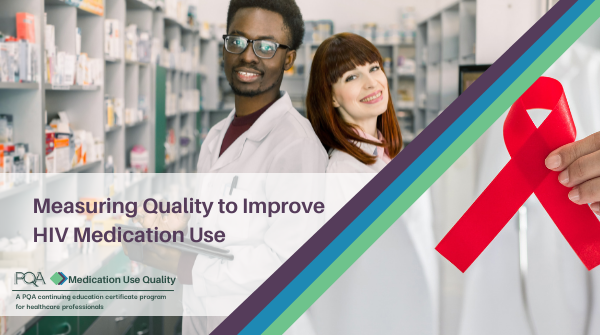The Importance of Medication Adherence in HIV Treatment and Prevention
Dave Hachey, PharmD, is one of PQA’s expert faculty for the new 3-hour continuing education course, Measuring Quality to Improve HIV Medication Use. Hachey is a Professor of Family Medicine at Idaho State University. He has more than 20 years of experience in the fields of HIV and family medicine, as well as more than 10 years of experience in hepatitis C management. In addition to discussing treatment and prevention modalities, Hachey outlines key indicators for the successful treatment of HIV
Why is it important for healthcare professionals at all levels to take a continuing e ducation course about medication adherence for HIV treatment?
ducation course about medication adherence for HIV treatment?
As healthcare professionals, when we look for CE programs, whether at a large conference or online, we tend to gravitate towards content we are comfortable with. However, to continue to grow as professionals and humans, we need to do something different that challenges and pushes us.
I have often tried to live one of my favorite quotes, “Life begins at the end of your comfort zone.” It’s how I landed in the field of HIV, and it has genuinely made me a better pharmacist (and human).
People living with HIV (PLWH) fought early in the HIV epidemic for effective medications, and when the world responded, regimens eventually became effective but were complex. Healthcare professionals and researchers understood that adherence was the common denominator for success for these regimens to be effective and to help PLWH survive. EVERYONE in the health care team needed to assess, evaluate, and support adherence. PLWH often (and unfairly) struggle with stigma, judgment from providers and pharmacists, shame, and many other barriers which create challenges in taking medication every day. Therefore, if we can find it within ourselves to get out of our comfort zone, you would be surprised how big of an impact we can have in the lives of PLWH.
In addition to HIV treatment, your lecture for PQA’s course highlights pharmacotherapy options for HIV prevention. What is the current state of U.S. prevention efforts?
Healthcare providers, public health workers, and others have the knowledge and tools to achieve the goals of “Ending the HIV Epidemic” by 2030. The FDA approved emtricitabine/tenofovir disoproxil fumarate (PrEP) for the prevention of HIV in 2012 and we need to continue to find ways to identify those at risk and use this tool to reduce transmission.
Although parts of the United States have made significant strides in reducing new infections, parts of the south and southeast United States are still struggling with reducing new infections. Reducing barriers, providing education, and increasing access to PrEP are all major pathways to achieving the goals of “Ending the HIV Epidemic”.
How do health disparities and the social determinants of health affect patients who are living with HIV, and how can pharmacists and care teams work with patients to address those factors?
The risk factors for acquiring HIV in the United States have remained constant for years, with the most common risk factor being men who have sex with men, followed by injection drug use and then heterosexual contact. However, when we add in complexities of social determinants of health such as economic stability, education access, health care access and neighborhood and built environments, this disease still affects certain populations disproportionately.
For example, because of complicated social constructs and inherent racism within healthcare systems and communities, people of color continue to be at a much greater risk of acquiring HIV. It is estimated that a gay black man has a 50% chance of acquiring HIV during his life, and that speaks volumes of how much more work we all must do to create equity in health care. We can start improving these social determinants of health and social inequities by looking at ourselves, being aware of our implicit biases and creating safe spaces for people of color and those who identify as LGBTQ in our clinics, pharmacies and communities.
Another module in this course, taught by two other expert faculty, discusses future medication adherence opportunities in HIV care. What do you see as the next steps for healthcare professionals in HIV related care?

There are newer medications for the treatment of HIV that allow a little more ‘forgiveness’ in non-adherence for PLWH. This means historically those taking antiretrovirals (ARVs) needed to be 95% adherent for the medication to keep the virus suppressed. Now, with more potent and durable medications with higher barriers to resistance, data suggest that patients may only need to be 80-85% adherent to maintain suppression. We certainly don’t tell patients to miss more doses now.
Still, healthcare professionals need to understand that we don’t need to demand perfection from our patients and should provide positive feedback for the work that they are doing. With the introduction of long-acting injectable medication, we need to be a resource for our patients and provide options for those who have adherence challenges.
You have more than 20 years of experience in the field of HIV and family medicine. What would you tell pharmacists and pharmacy students who are interested in focusing on HIV treatment and prevention?
Anyone who wants to focus on caring for PLWH needs to put the patient first. The HIV workforce is shrinking, and we are so close to reaching significant goals of controlling this disease. People who want to make HIV a central part of their practice need to commit to staying informed and educated, but most of all compassionate. PLWH need places that are safe for them to receive care and access their medications, and if we can continue to build those spaces, we can build better communities and better people.
In addition to PQA’s continuing education course, Hachey recommends the following resources related to the perspectives shared in this blog:
-
Major disparities persist in lifetime risk of HIV diagnosis in the US (February 2016)
